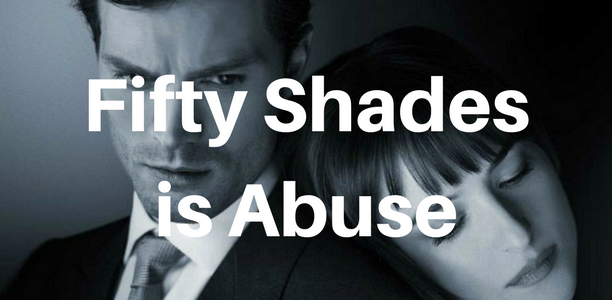By Jenelle Stone
February 11, 2015
Deseret News
Popular film site IMBD lists “BDSM” (bondage, domination, sadism and masochism) and perversion as just a few of the many plot keywords for an upcoming movie. No, it won’t be a video-only release with brown paper wrapping. The movie will be released on the big screen at your local movie theater. Based on the novel by the same name, “Fifty Shades of Grey” is slated for release on Valentine’s Day 2015.
Why is a movie (or book) that capitalizes on bondage and out-of-control male domination being billed as an appropriate story at all, let alone a love story released on Valentine’s Day? And are we as a society comfortable with letting sexual exploitation become so commonplace that we pay money for it and call it “date-night?”
It’s no surprise that multiple groups are boycotting the film.
USA-based Stop Porn Culture and the London Abused Women Centre of London, Ontario have come together to create one such group. Their campaign, #50DollarsNot50Shades, encourages patrons to donate $50 to a domestic violence shelter instead of spending that money on the movie, popcorn, drink, and babysitter.
Dr. Gail Dines, a professor of sociology at Wheelock College and the founding president of Stop Porn Culture says, “We want to raise awareness about the way the books and the film eroticize violence against women and rebrand violence as romance. We are asking people to donate to domestic violence shelters because women like Anastasia (from the book) usually end up running for their lives to such shelters after a “relationship” with a Christian Grey. The less fortunate end up dead.”
Megan Walker, the executive director of the London Abused Women Centre, points out that “in Canada, 1 in 4 women will be abused by her partner and 50 percent of all women over the age of 16 will be sexually violated at some point in their life. These women walk amongst us every day. It is an issue of epidemic proportions.”
Walker goes on to say, “What we also know is that the most dangerous place for women is in their own homes. And so it’s not as likely that somebody is going to be raped or assaulted on the street, although that happens, but it is very common to see sexual violence within intimate relationships in their own homes where they are really trapped in many cases. And so we believe that those who choose to support ‘Fifty Shades of Grey’ whether buying the book or seeing the movie are turning their backs on women who are trying to live their lives free from violence and abuse.”
Dines describes the women who have ended up in shelters after a “Fifty Shades” relationship as “battered, traumatized, depressed, anxious, and they often blame themselves.”
#fiftyshadesisabuse, a project of the National Center on Sexual Exploitation, has also joined the campaign. Their website hosts facts, spotlights and links to support their argument that “‘Fifty Shades of Grey’ glamorizes and legitimizes violence against women through sexual violence, abuse of power, female inequality, and coercion.”
The National Center on Sexual Exploitation websitestates that, “People often think ‘Fifty Shades’ will teach you how to please your partner, but really it just teaches the dominant one to please only his or herself.”
So, what about the argument that some women consent to this type of behavior?
The #fiftyshadesisabuse website points out that, “The acts practiced in ‘Fifty Shades of Grey,’ in “kink” pornography, and in BDSM (bondage, domination, sadism and masochism) relationships often violate U.S. and United Nations laws on torture. Consent is not an excuse according to these laws.”
Walker describes that many women in these types of relationships don’t feel able to leave. Sometimes they are threatened, afraid of losing custody of their children to their abuser, or don’t have the financial means to leave.
“The issue of consent is very complex because without understanding the dynamics of abuse or assault you cannot understand that women’s consent in those relationships is limited or non-existent.” says Walker.
So, in other words, this type of story isn’t fiction, and it certainly isn’t romantic. If anything, it’s a documentary. This is real life tragedy.
By glamorizing these abusive, trapping relationships, “Fifty Shades of Grey” is making light of the all too real struggles and nightmare circumstances of these victims.
It sends the message that no matter what your intimate partner may say, it is completely acceptable to act in a sexually demeaning way. That women are nothing but play-things in a man’s world, and that it’s great if you are a sex-crazed, dominating, pain-loving male or a women who submits herself to abuse. And why is it great to be these things? Because they’ll make a movie about you someday and bill it as a love story.
It’s a sad, painful, and demeaning story that rings true across the globe. Is the woman or child who has been sold into slavery and has to deal with these things in real life happy to hear that there are women who can’t wait to watch their type of horror play out on the big screen? Or what about the woman sitting in a shelter right now who may be psychologically and physically scarred from “Fifty Shades” type acts from her spouse? Would “50 Shades” fans look at her wounds which might never fully heal and call hers a love story?
Doubtful.
These women find themselves in situations that are out of control.
Dines, speaking of victims of “Fifty Shades” relationships, says, “[Fifty Shades of Grey] renders their experiences invisible by sexualizing the violence that was done to them. It also makes it more difficult for them to come forward because sadistic sex is being packaged as fun and edgy.”
“[Women] are at a loss as to explain how anybody can find that book or the movie coming out as entertainment given it’s their real life of torture and submission and assault and total lack of control in their lives.”
Walker describes the feeling amongst victims, “So there’s great concern by women coming into our office that so few people are recognizing ‘Fifty Shades of Grey’ as a story of abuse and assault.”
When we turn our backs on the victims, we turn our backs on the problem. When we romanticize sexual violence and exploitation we increase the risk that there will be more and more circumstances of this type of domestic violence, and that the victims of this violence will be increasingly damaged because society has chosen to accept their personal hell as romantic and fun.
Is this really the kind of non-empathetic, abandoning society that we want to create? For ourselves? For our children? For victims?


